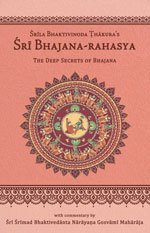Bhajana-Rahasya
by Srila Bhaktivinoda Thakura Mahasaya | 2010 | 123,965 words
The Bhajana-rahasya Text 37, English translation, including commentary (vritti). The Bhajana-rahasya is a compilation of verses describing the mercy of the eight pairs of names (Yugala-nama) of the Maha-mantra. This is text 37 belonging to the chapter “Prathama-yama-sadhana (Nishanta-bhajana–shraddha)” representing the last six dandas of the night: approximately 3.30 a.m.–6.00 a.m.
Text 37
Śrīmad-Bhāgavatam (6.3.22) states:
एतावान् एव लोके’स्मिन् पुंसां धर्मः परः स्मृतः
भक्ति-योगो भगवति तन्-नाम-ग्रहणादिभिःetāvān eva loke’smin puṃsāṃ dharmaḥ paraḥ smṛtaḥ
bhakti-yogo bhagavati tan-nāma-grahaṇādibhiḥOnly the worship of Bhagavān Śrī Vāsudeva, performed through nāma-saṅkīrtana, is called bhakti-yoga. This alone is the supreme dharma for the living entities.
भक्ति-योग कृष्ण-नाम ग्रहणादि रूप
‘पर-धर्म’ नामे तार निर्णीत स्वरूपbhakti-yoga kṛṣṇa-nāma grahaṇādi rūpa
‘para-dharma’ nāme tāra nirṇīta svarūpa
Commentary: Bhajana-rahasya-vṛtti:
Only nāma-saṅkīrtana is directly bhaktiyoga, and in Kali-yuga it is the only means by which Śrī Vrajarājanandana can be controlled. A question may arise here: if sense enjoyment and so forth are easily attained through nāma-kīrtana, why are learned persons teaching karma-yoga? The answer is that the intelligence of Yājñavalkya, Jaiminī and the other compilers of dharmaśāstras was often bewildered by Māyā-devī. Their minds remained attracted to the beautiful explanations given at that time of the Ṛg, Yajur and Sāma Vedas, and they were engrossed in the various kinds of activities by which, with great difficulty, one obtains the insignificant and temporary result of attaining Svarga (the heavenly planets). The topmost dharma is nāma-kīrtana, which is easily performed; however, they were unable to understand this.
